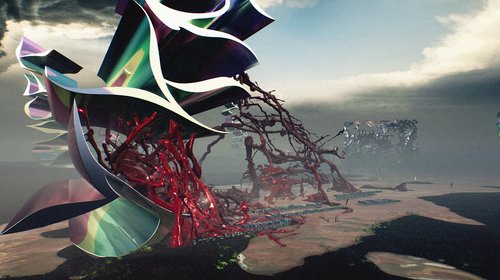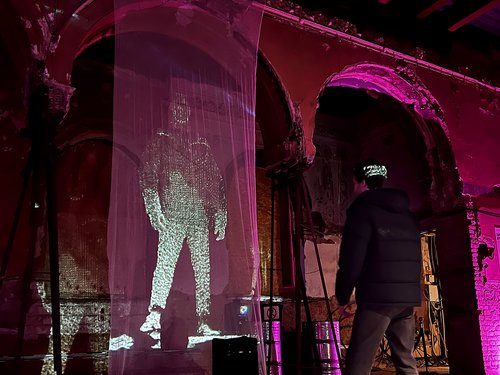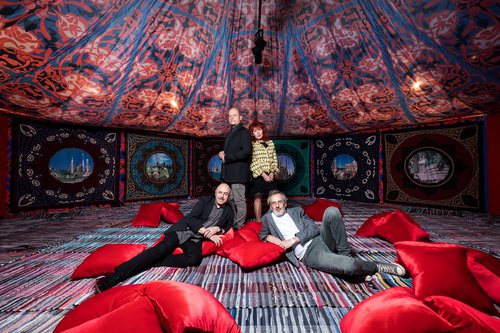In Ginzburg’s ‘Altered Space’ Modernism Meets AI

Anton Ginzburg. Walking the Sea #20 from 'Walking the Sea Portfolio', 2013. Courtesy of Fundación Pablo Atchugarry and the artist
Russian-born New York based artist Anton Ginzburg’s multidisciplinary art spans two-dimensional, sculptural and time-based media and explores the intersection between modernist abstraction and new technologies. His most recent exhibition ‘Altered Space’ at the Fundación Pablo Atchugarry in Miami integrates contemporary digital techniques with a sophisticated understanding of both traditional art forms and most recent technological advancements.
In his current solo exhibition at the Fundación Pablo Atchugarry, ‘Altered Space’, artist Anton Ginzburg (b.1974) draws on modernist principles around the evolution of avant-garde geometric forms and their connection to new technologies. Ginzburg’s parents emigrated from Soviet Russia to the United States when Ginzburg was a teenager, at the dawn of perestroika, and now fifty years later, his roots still hold him in place aesthetically even after decades of creative production. Both of his parents were engineers and in their home research as an activity per se was revered, later becoming a mainstay of Ginzburg’s creative processes, as he tells me: “I grew up with parents who were engineers, which led me to build my artistic practice with a strong awareness of new technologies and there is always an analytical approach in my work.”
As a young man, Ginzburg began his art studies at Parsons and received his master’s degree at Bard College and more recently he did a Ph.D. at Middlesex University in London. Currently he is teaching at the Pratt Institute and The New School, Parsons in New York and holds lectures mainly in northeastern American institutions such as Columbia University, NYU Tisch School of the Arts, University of Pennsylvania, School of Visual Arts, University of Massachusetts, Amherst, and in Canada at the University of Lethbridge in Southern Alberta. His artwork has been exhibited at the Venice Biennale, Contemporary Calgary, the Palais de Tokyo in Paris, and the San Francisco Museum of Modern Art and his films have been featured at seminal art film festivals such as the Whitechapel Gallery in London, the Rotterdam International Film Festival, and the New York Film Festival.
Before his doctorate studies at Middlesex University, during the pandemic, in 2021 Ginzburg spent half a year in Germany as a research fellow at the Schaufler Lab at the Technische Universität Dresden. His topic was ‘Artificial Intelligence as a Factor and Consequence of Societal and Cultural Change' in which he explored how AI could alter the production and conceptualization of artistic work. For Ginzburg AI is a creative collaborator rather than a tool. He likes to push the boundaries of traditional artistic practices, where once the artist’s hand was the sole creator and he allows the machine's computations to influence and shape the final aesthetic of a work in doing so giving a new definition to process-oriented artwork.
Analysing masses of data, he did a sentiment analysis of the scripts of iconic movies. Algorithms then generated patterns and forms that served as the foundation for what became two videos and sculptures which he is exhibiting now in ‘Altered Spaces’. He assessed twelve famous film scripts using ‘Film Forms’ resulting in four distinctive works: ‘American Psycho’ which exists both as a video and a sculpture, and ‘Predator’ and ‘Trainspotting’ which are sculptures; they have a biomorphic, minimalist aesthetic (the same algorithm is used in the field of social media to create sentiment analyses which determine the appropriateness of content to a specific context).
Elsewhere in the show, in a 3 ½ minute video work, called ML CRSH Ginzburg inputted images of the German city of Dresden into a computer, and the resulting AI database with a gaming engine has created a glitchy and mildly hallucinogenic animation in which structural details melt and morph into one another, where driverless cars crash into public artworks, in a quick and repeated fashion creating a constant feeling of tension and anxiety. These recurring scenes of seemingly endless crashes evoke the slapstick humor of Buster Keaton. “My work is rooted in post-conceptual art practice, but it focuses on ‘constructed geographies’ as a synthetic framework and material expression of our culture. The notion of ‘constructed geographies’ forms an organizational principle that allows one to observe the development of place as it undergoes semantic, material, and historical transformations”.
The pace in the exhibition changes with the video ‘Walking the Sea’, which shows Ginzburg walking alone through an arid landscape wearing on his back a tri-mirrored form, the mirrors each creating the illusion that they reflect the sea. Walking stick in hand, he wanders, destination unknown. Long ago the Soviets diverted rivers that once fed into the Aral Sea to local cotton fields, and eventually they evaporated. Also in the show, the textile work ‘Aral Sea Tapestry: sea-cotton-image’, addresses this environmental disaster and the imagery links it with ‘Walking the Sea’. Elsewhere ‘Whirling Vases’ is a sculptural installation of three white biomorphic vessel forms, a fourth in nickel partially patinated, which echoes the green of the Aral Sea tapestry work, there is a Muybridge-like sequence showing the sea’s disappearance.
The absence of the sea perhaps reflects on a deep level Ginzburg’s own personal biography – his first passport located him as a child of the Soviet Union, a place which no longer exists. “As a Soviet teenager emigrating to the USA in the 1990s, my identity was shaped by conflicting cultural narratives and lived experiences in both countries.”
Anton Ginzburg: Altered Space
Miami, Florida, USA
8 June – 7 September, 2024

















